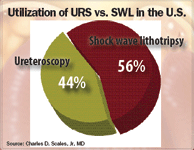Article
Shock wave lithotripsy use for kidney stones higher than ureteroscopy despite retreatment rate
In treating patients with urolithiasis, shock wave lithotripsy is used more often than ureteroscopy, even though patients undergoing SWL are more likely to undergo a second procedure.

Aggregate annual expenditures for stone treatment are second only to the costs of treating urinary tract infections among urologic conditions in the United States, explained Charles Scales, Jr, MD, chief urology resident at Duke University Medical Center, Durham, NC, in presenting the first of two studies assessing the utilization of SWL and URS in the U.S.
The studies, part of the Urologic Diseases in America Project, were derived from a 5% sample of Medicare patients across the nation. The results demonstrated that SWL was used more often than URS (56% vs. 44%), although SWL patients were 1.54 times more likely to undergo a second treatment. The researchers also found that non-clinical factors may influence treatment decisions.
"There is also some variation in the use of second procedures following an initial procedure, which may speak to quality of care. These studies raise more questions than we are able to answer using only Medicare billing data. The next step is to look at data that includes clinical factors such as stone size and location," said Dr. Scales, who was first author of both studies, working with Glenn Preminger, MD, and colleagues.

Dr. Scales, reporting the results at the AUA annual meeting in San Francisco, could only speculate as to why physicians fresh from residency programs were more likely to employ URS. He noted that URS has enjoyed a number of significant advances during the past decade that make it less technically challenging. He also said that URS may be one of the dominant treatment modes in urology training programs and that younger doctors may be more comfortable with the procedure's technology than those who completed training several years ago.
The age of the patient, race, income, and facility ownership were not factors in clinical decisions. The association between facility ownership and clinical decision-making has sometimes been a contentious issue.
"As far as we can tell with these studies, being for-profit, non-profit, or government owned does not seem to influence practice patterns, but we did not address this issue as specifically as others have done," Dr. Scales said.
A number of factors weighed on the incidence of second treatments. Patients treated at high-volume hospitals and those treated at teaching hospitals were more likely to undergo second procedures. The former finding may or may not be a curiosity owing to a generally accepted observation that high-volume institutions produce better outcomes. The higher second procedure rates seen at high-volume and teaching hospitals may merely reflect the treatment of patients with larger or more complex stones, Dr. Scales said.




